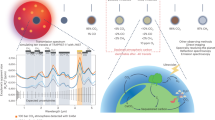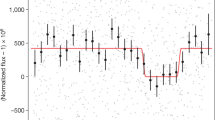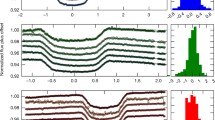Abstract
Considering the future importance of the search for evidences of primitive life on a distant planet, we have revisited some points of the O2 and O3 detection criteria.
The budget of free oxygen and organic carbon on Earth is studied. If one includes the organic carbon in sediments, it confirms that O2 is a very reactive gas whose massive presence in a telluric planet atmosphere implies a continuous production. Its detection would be a strong indication for photosynthetic activity, providing the planet is not in a runaway greenhouse phase.
In principle, the direct detection of O2 could be possible in the visible flux of the planet at 760 nm (oxygen A-band) but it would be extremely difficult, considering the much larger flux from the star. The alternative search for the 9.7µm absorption of O3 may be easier as the contrast with the star is improved by 3 orders of magnitude. A simple atmospheric model confirms that the O3 column density is not a linear tracer of the atmospheric O2 content, as was found in the pioneer work by Paetzold (1962). However, the detection of a substantial O3 absorption (τ > 30%) would probably indicate, within the validity of this model, an O2 ground pressure larger than 10 mbar. The question is raised of whether this pressure is sufficient to indicate a photosynthetic origin of the oxygen. If the answer was positive, it would be an evenmore sensitive test of photosynthetic activity than the detection of the oxygen A-band. Further studies of these points are clearly needed before determining an observing strategy.
Similar content being viewed by others
References
Angel, J.R.P., Cheng A.Y.S. and Woolf, N.J.: 1986,Nature 322, 341.
Chapman, S.: 1930, A Theory of Upper Atmospheric Ozone,Mem. Roy. Meteorol. Soc. 3, 103–125.
Holland, H.D.: 1990,Nature 347, 17.
Lovelock, J.E.: 1975,Proc. Roy. Soc. London B189, 167.
Owen, T.: 1980, in M.D. Papagiannis, ed(s).,Strategies for the Search for Life in the Universe, Reidel Publ. Co., 177–185.
Paetzold, H.K.: 1962,Mem. Soc. Roy. Sci. Liège vol. 7, La Physique des Planètes, 452.
Schneider, J.: 1992, in: J. Tran Thanhet al., ed(s).,Frontiers of Life, éditions Frontière, Paris.
Siegenthaler, U.: 1986, in: P. Buat-Ménard, ed(s).,The Role of Air Sea Exchange in Geochemical Cycling, Reidel, NATO-ASI Series, 209–247.
Traub, W.A., Carleton, N.P., Connes, P. and Noxon, J.F.: 1979,Ap. J. 229, 846.
Walker, J.C.G.: 1977,Evolution of the Atmosphere, MacMillan, New York.
Author information
Authors and Affiliations
Rights and permissions
About this article
Cite this article
Léger, A., Pirre, M. & Marceau, F.J. How to evidence life on a distant planet. Astrophys Space Sci 212, 327–333 (1994). https://doi.org/10.1007/BF00984536
Issue Date:
DOI: https://doi.org/10.1007/BF00984536




